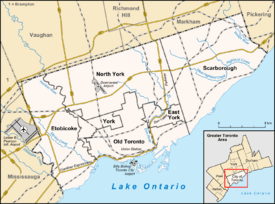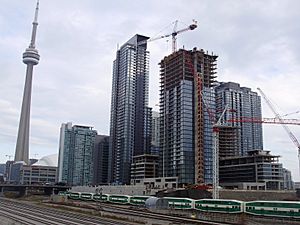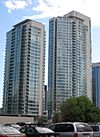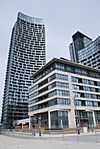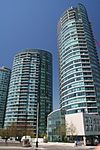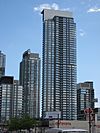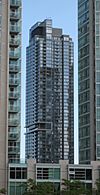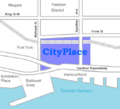CityPlace, Toronto facts for kids
Quick facts for kids
CityPlace
|
|
|---|---|
|
Neighbourhood
|
|
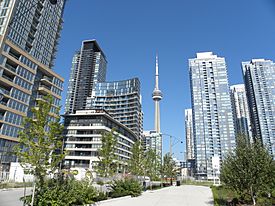
View of CityPlace with CN Tower in the centre background
|
|
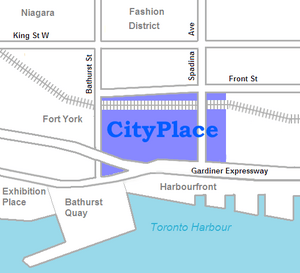
Vicinity
|
|
| Country | Canada |
| Province | Ontario |
| City | Toronto |
CityPlace is a modern neighbourhood in Downtown Toronto, Ontario, Canada. It's built on what used to be old train yards. When it's all finished, CityPlace will be the biggest housing project ever built in Toronto!
This area is surrounded by Bathurst Street to the west and Lake Shore Boulevard to the south. To the north is Front Street, and to the east are Blue Jays Way and the Rogers Centre. CityPlace is also super close to King Street West and Liberty Village. You can even walk to Toronto's main financial area in about 10 to 20 minutes. The neighbourhood is also home to Canoe Landing Park, which was designed by the famous Canadian writer and artist Douglas Coupland.
Contents
Discovering CityPlace's Past
How CityPlace Began
CityPlace was built on land that used to be a big train yard for the Canadian National Railway. This area was part of the larger "Railway Lands" near the waterfront.
Back in 1965, the Canadian National Railway started moving its train operations. They wanted to use this downtown land for new projects. One idea was to build a huge tower to show off Canadian industry. This idea became the CN Tower in the 1970s.
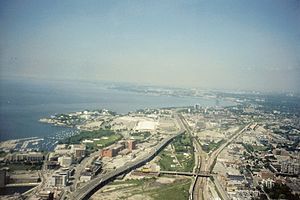
Later, in the 1980s, more development happened. The Metro Toronto Convention Centre opened in 1984. This brought new attention to the area.
Building a New Community
With more visitors coming, the City of Toronto made a new plan for this area. The last train operations moved out, making the land ready for building. Construction began with the SkyDome, which was finished in 1989.
At the same time, new roads, parks, and other important structures started to appear. The project was going well until a tough time for the economy in the early 1990s. Many building plans were put on hold. The land stayed empty until 1997, when work began on the Air Canada Centre arena.
The Final Phase of Building
This led to the third and final part of the project, called CityPlace. The plan was to build a mix of homes, shops, and businesses. Concord Adex Developments bought the land in 1997. This company also helped build a big area in Vancouver that used to be part of Expo 86.
One of the last parts of CityPlace to be built is called Block 31. This area will have two schools and a new community centre. The Toronto District School Board (TDSB) and the Toronto Catholic District School Board (TCDSB) will both use these new spaces. The schools will share a gym and a theatre. This helps save space and create more green areas.
The schools are named Jean Lumb Public School and Bishop MacDonell Catholic School. Jean Lumb was the first Chinese Canadian woman to receive the Order of Canada for her community work. Alexander Macdonell was the first bishop of Kingston in Upper Canada.
CityPlace by the Numbers
CityPlace is a huge project!
- It covers about 18 hectares (that's like 44 football fields!).
- It includes an 8-hectare community park.
- When finished, it will have 7,500 homes.
- The homes are in 10 main areas, called street blocks. Each block has several tall buildings and its own shared facilities.
- Block 9 is home to the 3.24-hectare Canoe Landing Park.
- So far, over 5,000 homes have been built!
Tall Buildings in CityPlace
CityPlace has many tall buildings. Here are some of the notable ones:
Getting Around CityPlace

CityPlace is easy to get to because it's located between the Gardiner Expressway and Union Station. The area also has great public transit. You can use the Toronto Transit Commission's streetcar lines: the 509 Harbourfront, 510 Spadina, and 511 Bathurst routes.
There are also plans for a future streetcar route along Fort York Boulevard, which is the main road through CityPlace.
A special footbridge, called Puente de Luz (which means Bridge of Light), connects CityPlace to Front Street. It goes over the train tracks and is for people walking and biking. It opened in October 2012. After a short closure for safety checks, it reopened in December 2012. This 100-meter bridge was designed by a sculptor from Chile named Francisco Gazitua.
Images for kids
-
View of CityPlace with CN Tower in the centre background


